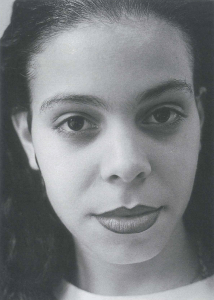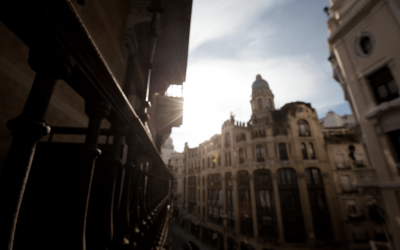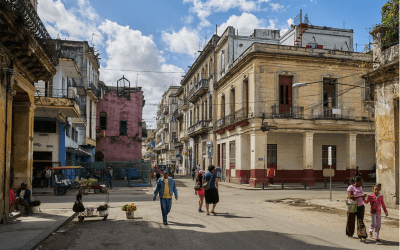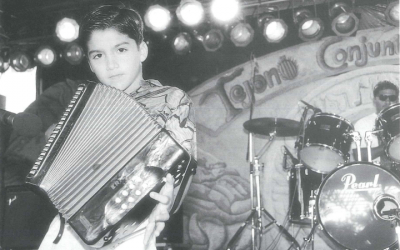Being Latina at Harvard
…and Beyond

Photo by Janice Rogovin, artist-in-residence at Greater Egleston Community High School in Jamaica Plain.
I came to Harvard in 1993. I guess I wasn’t the traditional student, if such a thing exists. I was born in a rural village in the Dominican Republic and immigrated to the South Bronx, New York City in 1982. In the South Bronx, I walked the streets for pleasure and insight, attended catholic schools where I learned of the English language, met and dismissed the “American dream”, and witnessed and experienced the devastation of poverty. I was not Latin@ then. I was ‘Julissa’ and ‘Shortie’ and, sometimes, ‘Dominican.’
To Harvard I went without a clue of its history or prominence. My guidance counselors had warned me of the legend, but to me it was all hearsay. My mother, aunt, two second cousins, and a friend of a friend escorted me to Cambridge, Massachusetts, that lovely September day. We drove a blue van–getting lost several times–from the Bronx to Harvard. Early that Saturday, I moved into Strauss 2-B, to a four-person share with sisters from all over the country: Florida, New York and Indiana; African-American, Asian-American and Jewish.
I spent my first year at Harvard observing others. For the life of me, I could not understand why folks needed to find out what I was and where I came from. Most wondered: ‘You must be Puertorican’; ‘Are you Latin@?’; and most commonly, ‘So how is the Bronx, anyway?’ My responses varied from ‘No, I’m Dominican, you know, from the Dominican Republic’ to ‘I guess’ to ‘Yeah, asshole, we all carry guns’. I did not understand these matters so I went forth and examined the Harvard life. And I quickly realized that many Harvardian colleagues were obsessed with portrayals and images and assumptions.
Really I did not miss my Dominicanness, nor did I miss the Bronx. They both went with me to Strauss, Widener, Adams, Emerson. Having a Dominican/Bronx identity was not a choice; it was the way I ate, walked, laughed, spoke, smelled, and thought. Y la música! – as if I could block the noise of guira and tambora from my ears.
As time progressed, I became more acquainted with the dynamics of being Latin@. I realized that that category that included myself was used by a very limited number of people at Harvard. And many of us had Dominican-sounding last names and stories of struggle stained with terms like “spic”. And, at the end of the day, to the eye of the beholder many of us also looked the same–with black, Indian and Spanish chemicals all over our systems. And university officials of all forms mentioned the Latin@ numbers as with pride but I always wondered: if they were so happy with Latin@s why didn’t they just come back to the ghetto and get some more–they were tons of us in the Bronx. I guess the intrigue of this new race and the undeniable familiarity with all its features drew me to it.
Organizations promoting Latin@ culture sprouted left and right during my undergraduate years. The small Dominican-within-the-Latino-community group even started our own thing–Fuerza Quisqueyana. The mission, not surprisingly, was to promote Dominicanness in all its forms, from arroz con guandules to Juan Luis Guerra to bachata mix. And I must tell you that actively promoting Dominicanness–i.e. promoting myself–was the most natural of extracurriculars.
My years at Harvard were indeed unforgettable. I met beautifully brilliant people with dreams of conquest and lucha. Many classmates shared their hopes of changing the world and their ideas for mastering life. And I took them all seriously. When solutions to inner-city crime were discussed, I registered them; when stories of travels through Africa and Europe were shared, I dreamed them. So, I went and tried to master the world–taking my fellow Harvardians’ ideas to heart–and believing that all those plans were to be tested. So I spent many nights at Harvard trying to figure out how to master life and experiment with ideas. My years at Harvard were spent exploring the world, traveling through Asia, Africa, Latin America and Europe–all in search of understanding and laboratories of experiment.
That habit did not changed. Upon graduating from Harvard, I went to the University of Cambridge in England to study Development Studies in a Masters of Philosophy program. There, I met dreamers from other worlds. And found that Latin@s and, even less so, Dominicans were even a rarer breed than at Harvard. But I found my tribe–another Dominican woman, a French-Puertorican Newyorker and couple of Mexicans. And in Cambridge, England miles away from the cradle of the new race, I understood Latin@ness.
After England, New York awaited. And it embraced me as if it would its prodigal daughter. Columbia Law School was my next haven; and Washington Heights, New York City’s predominantly Dominican New York City neighborhood where I live, serves as the new fountain of ideas, as a playground to experiment with problems and solutions. In New York, I have found a home for my ideas of bettering life and giving voice to the silenced. I study law at an outstanding institution, and organize and share with my communities–all in the same pulse.
In New York City, I see myself in every corner–there’s no explaining required. I walk and talk like a Puertorican; I eat and laugh like a Mexican; I smell and think like a Dominican. Y la música!
In New York, I am Julissa again.
Related Articles
Forum on U.S. Hispanics in Madrid
The Trans-Atlantic Project, an academic initiative to study the cultural interactions between Europe, the U.S. and Latin America has been invited by Casa de América, Madrid, to present a …
Cuba Study Tour
Waiting at José Marti International Airport for the first Harvard students to arrive for January’s DRCLAS Cuba Study Tour, my companion, a theater critic at Casa de las Américas, commented to me …
The Soulfulness of Black and Brown Folk
And so, by faithful chance, the negro folksong – the rhythmic cry of the slave – stands to-day not simply as the sole American music, but as the most beautiful expression of human experience …




